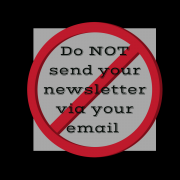Do NOT send your newsletter via your email
Are you thinking of starting a newsletter and sending it via your firm’s email? Stop. Sending newsletters using your firm’s email client—whether it’s Microsoft Outlook or some other program—is a bad idea. It can anger people, and handicap the delivery of your newsletter. But, don’t worry. There’s an easy solution.
An easy way to annoy newsletter recipients
I’m thinking about this because I just received a mass email from someone who’s launching a new business. This person emailed me—and maybe 20 other people—in a message that displayed our emails in the CC line.
It’s not a good idea to expose other people’s email addresses if they don’t already work at the same company or correspond via email for other purposes. People like their privacy. In the case that I’m thinking of, the other recipients were all people who had taken a class together, so many of them may have welcomed the chance to stay in touch. But some might not.
Another problem: When you send a mass email using the CC line, inevitably some people will “respond all.” That’s true even when their message is of no interest to the other recipients. This is annoying.
A way to handicap your newsletter delivery
You might think that using the BCC line to blind-copy recipients would solve your problems. Sure, it’ll solve the problems listed above. But there are other issues with sending newsletters via your firm’s email software.
Internet service providers (ISPs) are suspicious of emails that have many addressees. They fear that you might be sending spam. Your email address could get blacklisted.
As e-mail marketing application MailChimp says in its explanation of blacklists, “If your emails get marked as spam, or ISPs see a sudden increase in email volume coming from your domain, you could get blacklisted.” Campaign Monitor, another email marketing app, notes that “Just a few spam complaints can land an IP address on a blacklist, even if the ratio of complaints to the volume of email sent is very low.”
That could hurt the delivery of your regular emails as well as your newsletters. That’s a high price to pay.
Solution: use an email marketing application
An email marketing application—I use Constant Contact—solves the problem of exposing recipient’s email addresses. It also gives your newsletter the chance to be viewed more favorably by ISPs than emails sent to many recipients via your firm’s email software.
For one thing, an email marketing app will make sure that you comply with certain standards set by the CAN-SPAM Act, an anti-spam law. It’ll force you to provide an unsubscribe link and to put your address in the email, as pointed out in “7 Reasons You Should Use An Email Marketing Service to Send Your Newsletters.” The same article asserts that “Email service providers such as Constant Contact and MailChimp are trusted within the email community and they keep a good eye on their account holders to make sure there is no funny business going on.” As Liz Lockard says in “5 Reasons Why Email Marketing Service Providers are a MUST,” “They keep a record of the opt-in when your subscriber signs up and also have things like spam filter checks to help you avoid the junk folder and being reported as spam.”
Other advantages of email marketing service providers:
- They give you the option to automate sign-ups to your newsletter with a link in your emails, on your website, or in other locations.
- They provide templates to help you format your newsletters attractively—and in a mobile-friendly way.
- They usually offer some sort of support, which can be invaluable when you run into problems with your newsletter.
You may still have problems
I wish I could say that email marketing service providers are the solution to all of your problems. They’re not.
Some companies block communications sent via such providers. I’ve run into this with subscribers to my Investment Writing newsletter. Some of my subscribers end up re-subscribing from their home email addresses, rather than battling their company information technology folks to get the newsletter whitelisted.
Still, if you follow my advice, you’re likely to have fewer problems than if you send newsletters via your regular email software.





Those are good points for email marketing. I think though that a more important point to consider when discussing newsletters is to send printed newsletters, rather than email ones. When you look at the open rate for email newsletters, in many industry segments, you’re doing great to get 25% of the recipients to open the emails. More and more, with flooded inboxes, people delete without evening opening the email.
Printed newsletters, on the other hand, have a much higher read rate in my experience. When we moved primarily to a printed newsletter format for my firm, we saw a better ROI in terms of referrals and repeat business. We also got far more comments from people about the printed newsletter than we ever did about an email newsletter. And, we get calls from people who want us to have their new address so they will continue to receive the printed newsletter.
Joel,
It sounds as if you’re using a printed newsletter effectively. I agree that a mailed printed newsletter can cut through the clutter.
In fact, I’ve blogged about that (http://www.investmentwriting.com/2016/11/print-newsletter-vs-e-newsletter-2/). You mentioned a higher ROI on your printed newsletter. One of the sources in my blog post also suggested that the higher response rate more than compensates for the higher costs of a printed newsletter.
Thank you very much for taking the time to comment!